ISS: 3D Print (3D Printing in Zero-G Technology Demonstration)
Human Spaceflight
ISS Utilization: 3D Print (3D Printing in Zero-G Technology Demonstration)
In preparation for a future where parts and tools can be printed on demand in space, NASA and Made In Space Inc. of Mountain View, CA, have joined to launch equipment for the first 3-D microgravity printing experiment to the International Space Station.1) 2) 3) 4) 5) 6)
The first mission, called the 3D Printing in Zero-G Experiment (3D Print), will study the long-term effects of microgravity on 3D printing. Made In Space will incorporate the lessons learned from 3D Print into the design of the AMF (Additive Manufacturing Facility), which will serve as a permanent manufacturing facility on the ISS, and is slated to begin operations by 2015.
Made In Space will be opening up the usage of the AMF to the space community, in order to enable organizations and individuals to print parts and do science on the ISS without the need for launching payloads. NASA, ESA, CSA, JAXA, Roscosmos, and all participating space agencies will have access to the AMF as well as commercial space sectors, research institutions, and individuals.
In April 2014, the 3D printer passed flight certification and acceptance testing at NASA/MSFC (Marshall Space Flight Center) in Huntsville, AL. The technology demonstration will print objects in the MSG (Microgravity Science Glovebox). - If the printer is successful, it will not only serve as the first demonstration of additive manufacturing in microgravity, but it also will bring NASA and Made In Space a big step closer to evolving in-space manufacturing for future missions to destinations such as an asteroid and Mars. 7)
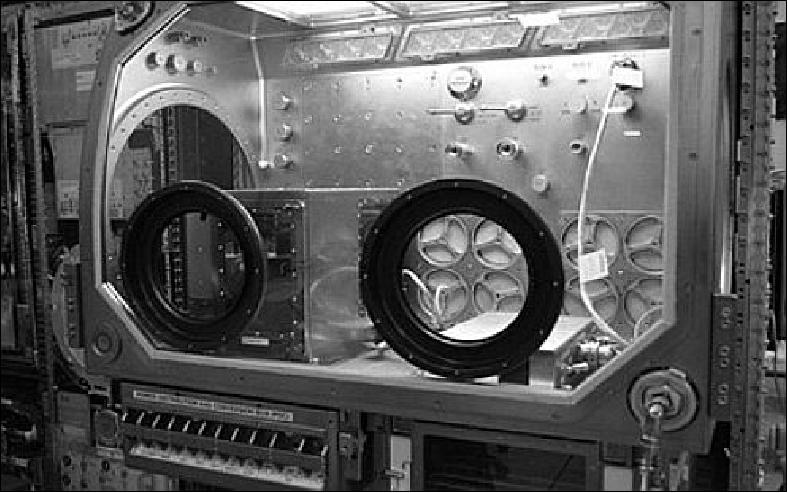
Background
Extrusion-based 3D printing is an AM (Additive Manufacturing) process in which objects are built up in a great many very thin layers. The 3D Print technology creates 3D physical prototypes by solidifying layers of deposited powder using a liquid binder.
Led by NASA's STMD (Space Technology Mission Directorate), the Agency has launched a couple of formal programs to prototype new design concepts and tools for current and future missions. In addition to working with the U.S. Air Force, NASA has joined America Makes, formerly known as NAMII (National Additive Manufacturing Innovation Institute), a public-private partnership created to transition the technology into the mainstream U.S. manufacturing sector. 8)
As a result of these efforts and others sponsored by the individual centers, teams of engineers and scientists are investigating how their instruments and missions might benefit from an industry that actually began more than two decades ago, with the introduction of the world's first 3D system.
In the early stages of development, the 3D Print hardware had to overcome some challenges to ensure that microgravity prints would not deviate from terrestrial prints. These challenges include: 9)
• Terrestrial printers are built with gravity assumed. In a zero-gravity environment certain components may move or ‘float' and even miniscule movement can ruin the printing process.
• Specific adjustments were made to ensure that surface tension is the only dominant force in the printing process. Without these adjustments the extruded material would not layer correctly.
• The contained environment of the ISS requires significant safety standards for any equipment brought to space. The Made In Space printer has passed all safety requirements.
• In microgravity fluids do not behave as they do on Earth since there is no natural convection, there is only forced convection and diffusive effects so the thermal process becomes essential.
• A 3D printer designed for space must also have a robust and stable design in order to survive the extreme loads and vibrations experienced during launch.
Having addressed these and other challenges in hardware design, 3D Print hardware successfully completed flight certification at MSFC in Huntsville, Alabama in May 2014. Onboard ISS, 3D Print will yield a series of parts, tools, and test coupons that will constitute the first items manufactured off-world. These parts will help satisfy a large portion of the mission goals. The overall goals of the 3D Print program are:
• Perform extrusion-based 3D printing onboard the ISS
• Demonstrate nominal operations including traversing and printing
• Mitigate risk for future manufacturing facility risks
• Have on-demand manufacturing capability
• Characterized extruded material and compare to Earth samples
• Perform STEM activities.
The 3D Print is an extrusion-based device that, once aboard station, will be testing in a long duration microgravity environment for the first time. The parts produced will be analyzed on Earth and the data they provide will determine what, if any, changes should be made to enhance the process and optimize it further for microgravity functionality.
3D Print Mission
The 3D Print mission will serve as the first in-space manufacturing platform and will be a proof of concept as well as produce viable components that will be for both functional and testing purposes. The ISS is a unique laboratory that is being utilized to
accomplish many of the goals of this mission. Without the use of the ISS, it would be extremely costly to test in the manner that is being planned. The hardware has been designed to reduce the amount of crew time that is needed to be spent for operations and maintenance. To achieve this, all software aspects of the hardware could be controlled from the ground and maintenance functions were constructed to reduce the number of items on the checklist for the crew.
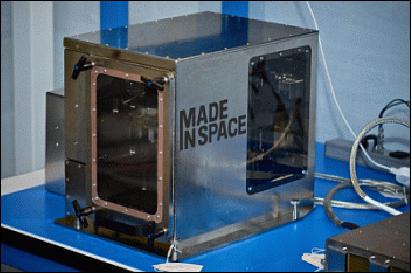
Launch
The 3D Print device was part of the cargo on the Dragon spacecraft of the SpaceX CRS-4 flight to the ISS, launched on September 21, 2014 (05:52:03 UTC) on a Falcon-9v1.1 vehicle. The launch site was SLC-40 at Cape Canaveral, FL.
Orbit: Near-circular orbit of ISS, altitude range of 375-435 km, inclination = 51.6º.
SpaceX CRS-4 is a cargo resupply mission to the ISS (International Space Station), contracted to NASA. It is the sixth flight for SpaceX's uncrewed Dragon cargo spacecraft, and the fourth SpaceX operational mission contracted to NASA under a CRS (Commercial Resupply Services) contract.
CRS-4 payloads:
Dragon delivers ~2270 kg of supplies and payloads, including critical materials to support 255 science and research investigations that will occur during Expeditions 41 and 42. Dragon carries three powered cargo payloads in its pressurized section and two in its unpressurized trunk. — Dragon will return with about 1725 kg of cargo, which includes crew supplies, hardware and computer resources, science experiments, space station hardware, and four powered payloads (recovery in the Pacific Ocean ~ 700 km off the coast of California). 10) 11)
• RapidScat is the primary payload on this CRS-4 flight of SpaceX.
• 3D Print device of Made In Space Inc. of Mountain View, CA. (Note: the 3D Print device is described in a separate file on the eoPortal)
• New permanent life science research facility. The Bone Densitometer (BD) payload, developed by Techshot, will provide a bone density scanning capability on ISS for utilization by NASA and CASIS (Center for the Advancement of Science in Space). The system measures bone mineral density (and lean and fat tissue) in mice using DEXA (Dual-Energy X-ray Absorptiometry).
For the first time, Dragon will carry live mammals – 20 rodents will ride up in in NASA's Rodent Research Facility, developed by scientists and engineers at NASA's Ames Research Center. The rodent research system enables researchers to study the long-term effects of microgravity—or weightlessness—on mammalian physiology.
Secondary payloads:
• Arkyd-3 is a 3U CubeSat technology demonstrator (4 kg) from the private company Planetary Resources Inc. of Bellevue, WA, USA, (formerly known as Arkyd Astronautics). The objective is to test the technology used on the future larger Arkyd-100 space telescope. The company has contracted with NanoRacks to take the Arkyd-3 nanosatellite to the ISS where it will be released from the airlock in the Kibo module. 12)

• SpinSat (Special Purpose Inexpensive Satellite), a microsatellite (57 kg) of NRL (Naval Research Laboratory), Washington D.C. SpinSat is documented in a separate file on the eoPortal.
• SSIKLOPS (Space Station Integrated Kinetic Launcher for Orbital Payload Systems). This launcher will provide still another means to release other small satellites from the ISS. This system is also known by the name of Cyclops and is described in the SpinSat file on the eoPortal. SSIKLOPS will be used to deploy SpinSat from the ISS. 13)
Mission Status/Status of Products
• April 27, 2023: The International Space Station (ISS) partners have agreed to extend the operational period of the ISS. The United States, Japan, Canada and participant European Space Agency (ESA) countries will support operations until 2030, while Russia has committed to continuing station operations until 2028. 20)
• August 10, 2015: In November of 2014, Made in Space made history when astronauts aboard the International Space Station (ISS) unpacked the world's first piece of manufacturing equipment designed to operate in space. The astronauts successfully 3D printed the first object ever made in outer space, a NASA designed buckle that is part of exercise equipment intended to prevent muscle loss in zero gravity environments. It was the first of twenty four different objects 3D printed aboard the space station, proving that the Made in Space Zero-G Printer worked as intended and could be used to create tools or replace many broken or damaged parts on the ISS without the need to wait for shipments from Earth. 14)
- This was only the first step, however. While the ability to 3D print objects, parts and tools directly on the ISS was an important development, Made in Space's ultimate goal is to create manufacturing technologies for extra terrestrial applications. The flexibility of in-space manufacturing is vitally important for long-term space missions. Not only will it allow the manufacture of components and tools that are too fragile to survive the massive g-forces involved with being launched into space, but will be a requirement for any extended space mission, such as the eventual colonization of Mars. Today the Mountain View, CA company announced that they have successfully taken another step in that direction.
- Since they successfully achieved zero gravity 3D printing last year, they have been working on technology that would allow astronauts to manufacture objects outside of the ISS in the vacuum of space. Just over a month ago, Made in Space completed a round of successful tests indicating that their newest generation of 3D printers will be fully functional in open space. The new technology will be the first machine capable of in-vacuum additive manufacturing.
- Last year's successful printing test was a precursor to Made in Space's commercial AMF (Additive Manufacturing Facility) which will be sent to the International Space Station later this year. All twenty four of the original parts have been sent back to Earth for laboratory analysis and comparison with identical objects 3D printed on Earth. These tests and the first round of printed parts are only the first phase of NASA's 3D Printing in Zero-G Technology Demonstration mission.
- For the second phase of the mission Made in Space tested a modified version of their AMF that includes proprietary vacuum-compatible extrusion heads. These test parts were produced using aerospace-grade thermopolymers to assess how well the deposition process functions within a vacuum. After a full week of testing inside of a vacuum chamber the preliminary results of these tests have been successful. While the vacuum 3D printing process worked exactly as expected, Made in Space will be testing the finished parts to detect any mechanical properties that differ from parts produced in Earth's atmosphere.
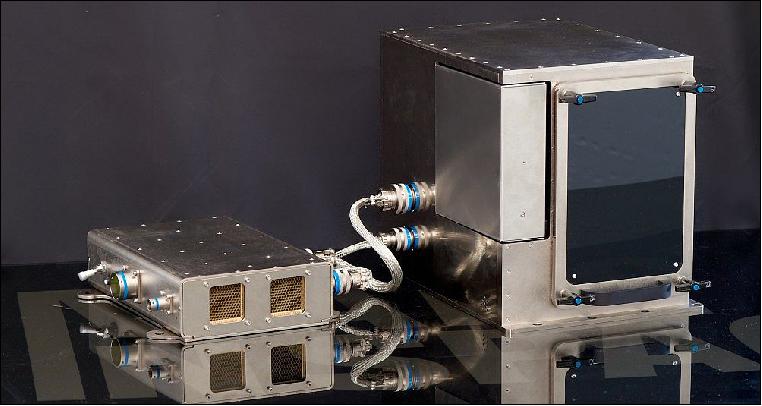
• April 7, 2015: Engineers at NASA/MSFC (Marshall Space Flight Center) in Huntsville, Alabama, unboxed some special cargo from the International Space Station on April 6: the first items manufactured in space with a 3D printer. The items were manufactured as part of the 3D Printing in Zero-G Technology Demonstration on the space station to show that additive manufacturing can make a variety of parts and tools in space. These early in-space 3D printing demonstrations are the first steps toward realizing an additive manufacturing, print-on-demand "machine shop" for long-duration missions and sustaining human exploration of other planets, where there is extremely limited ability and availability of Earth-based resupply and logistics support. In-space manufacturing technologies like 3D printing will help NASA explore Mars, asteroids, and other locations. 15)
- The 3D printer on the ISS used 14 different designs and built a total of 21 items and some calibration coupons. The parts returned to Earth in February 2015 on the SpaceX Dragon. They were then delivered to Marshall where the testing to compare the ground controls to the flight parts will be conducted. Before the printer was launched to the space station, it made an identical set of parts. Now, materials engineers will put both the space samples and ground control samples literally under a microscope and through a series of tests. Project engineers will perform durability, strength and structural tests on both sets of printed items and even put them under an electron microscope to scan for differences in the objects.
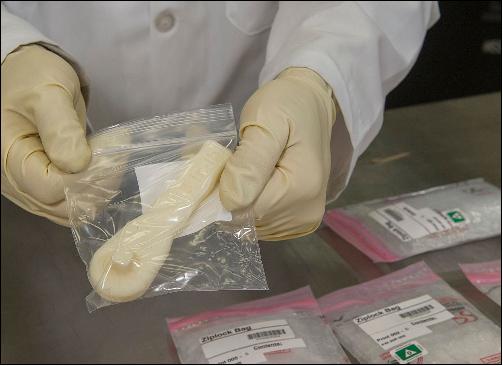
• Dec. 17, 2014: The Zero-G 3D Printer, currently aboard the space station, is a technology demonstration to observe how a long duration microgravity environment affects the additive manufacturing process. Until today, all of the objects that were printed in-space had previously been printed on the exact same printer before it was ever launched to increase the chances of success. Additionally, until today, backup files of all of the models printed have been available on an SD card that was launched with the Zero-G Printer. Today, for the first time, Made In Space uplinked a design which did not exist when the printer was launched. In fact the ratchet was designed, qualified, tested, and printed in space in less than a week. 16)
- The ratchet was designed as one print with moveable parts without any support material. The parts and mechanisms of the ratchet had to be enclosed to prevent pieces from floating in the microgravity environment. Once the design was finalized, the ground station print of the ratchet was sent to NASA authorities for a safety qualification. After qualification, the file for the ratchet was emailed to the ISS laptop connected to the Zero-G Printer. Once the design of the ratchet was uplinked to the space station, Made In Space engineers conducted a checksum to verify that the file was uploaded correctly before ultimately sending the command to initiate the print.

- The ratchet took 4 hours to print and the space station even flew over California for the first time while the Zero-G Printer was operating. The ratchet will be returned to Earth along with all of the other parts printed so far in order to perform detailed observations on the differences between made in space parts and the corresponding parts that were printed on Earth.
• Nov. 24, 2014: History was made today when the first 3D printer built to operate in space successfully manufactured its first part on the ISS. This is the first time that hardware has been additively manufactured in space, as opposed to launching it from Earth. 17)
- The first part made in space is a functional part of the printer itself – a faceplate for its own extruder printhead. "This ‘First Print' serves to demonstrate the potential of the technology to produce replacement parts on demand if a critical component fails in space," said Jason Dunn, Chief Technical Officer for Made In Space.
- For the entirety of the space program, tools and parts have been built on Earth and required a rocket to get to space. The presence of a 3D printer onboard the ISS will allow hardware designs to be made on Earth and then digitally beamed to the space station, where the physical object will be created in a matter of hours. "For the first time, it's no longer true that rockets are the only way to send hardware to space," said Mike Chen, Chief Strategy Officer for Made In Space.

- The initial phase of this science experiment will see a selection of test coupons, parts and tools printed in order to validate design, methodology and technology assumptions. Made In Space will print the same objects on their identical ground unit in order to provide a group of control prints. The ISS prints will be returned to Earth via a future return flight in order for the control prints and microgravity prints to be compared.
- Once returned to Earth, the testing of the prints will provide data on a wide variety of factors, including tensile strength, torque, and flexibility. This information will allow the Made In Space team to make crucial adjustments to a second 3D printer, scheduled for delivery to the ISS in early 2015. This second printer will be an invaluable tool for astronauts and the government. It will also be available to commercial businesses and individuals on Earth to create on-demand hardware such as small satellites.
• November 17, 2014: The 3D printer is installed in the Microgravity Science Glovebox on the International Space Station. Station commander Barry "Butch" Wilmore of NASA installed the space 3D printer inside the orbiting lab's Microgravity Science Glovebox on Nov. 17 (Figure 9). The machine and its software are in good operating condition, and the first test items will likely be printed soon, NASA officials said. 18)
- Wilmore started the printer after installation which extruded plastic to form the first of a series of calibration coupons, a small plastic sample about the size of a postage stamp. - After calibration of the printer is complete and verified, the printer will make the first NASA-designed 3D printed object in space.

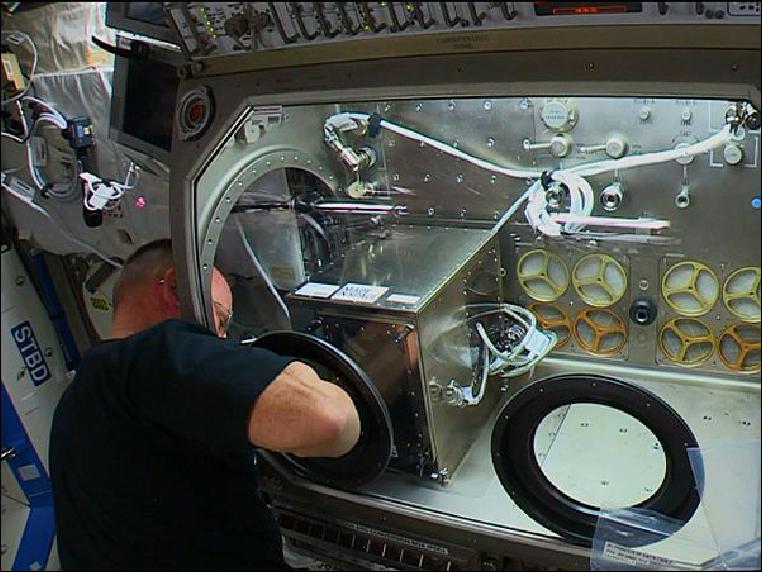
• On Sept. 23, 2014, the Dragon cargo capsule arrived at the ISS and was berthed to the Space Station's Harmony module. 19)
Setup and Operations onboard the ISS
The 3D Print hardware will be installed in the MSG (Figures 8 and 9), after being delivered by the SpaceX CRS-4 mission. The MSG (Microgravity Science Glovebox) supplies the hardware with all the required safety and power interfaces as well as video feed. The printer will be controlled by the attached electronics box, which communicates with the MSG laptop computer. All operations of the 3D Print mission can be executed from the ground with the exception of part removal from the printer or performing maintenance procedures.
The POC (Payload Operations Center) at NASA/MSFC is responsible for the operations however Made In Space will be crucial for the execution of commands and performing operations on the hardware while it is operating and verifying all pre-planned procedures are carried out nominally.
Once set up aboard ISS, the payload will be used to print a number of components as part of a proof-of-concept test of the properties of melt deposition modeling additive manufacturing in the microgravity environment. The system uses ABS (Acrylonitrile Butadiene Styrene) thermoplastic resin to produce 3D multi-layer objects. The generated objects are compliant with ASTM (American Society for Testing and Materials) standards which will allow an objective assessment of a number of parameters including tensile, flexure, compressional, and torque strength as well as layer thickness, layer adhesion, relative strength, and relative flexibility.
Multiple copies of parts will be printed to gain insight into strength variance and the implications of feedstock age. In parallel, an identical 3D printer will be used on Earth to produce the same components. These duplicated components will be used to analyze differences in properties between Earth- and space-manufactured parts which can be useful in refining 3D printing techniques for terrestrial applications.
Current cases for using additive manufacturing on-orbit include (Ref. 8):
Predicted replacements and repairs- using additive manufacturing would limit the amount of stored parts. A recent internal NASA study analyzed the failures that ISS hardware has had in the past. Out of those failures, 82% were determined to be candidates for additive manufacturing to be used for the component or system (Figure 10). Out of that 82%, 28.6% consisted of plastics and composites which can be produced from extrusion based additive manufacturing.
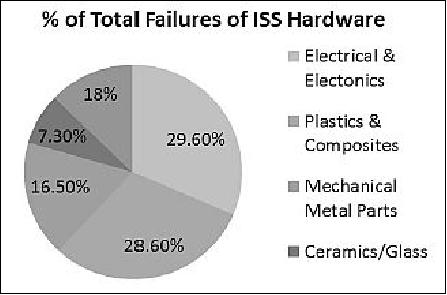
• Unknown replacements and repairs - Having a manufacturing capability is the only way for a rapid and optimal fix in this case. Everything going to space currently has to be launched, if an unpredicted circumstance presents itself presently a solution either has to be improvised or wait to be flown up on the next resupply vehicle.
• Payload advantages- With the availability of a manufacturing facility payloads are able, for the first time, to perform rapid iterations or additions to hardware. Another interesting attribute is for payload developers to design parts of their experiments that can only be produced in the microgravity environment.
The 3D Print will demonstrate the capability of having a machine shop type capability in space for the first time. This serves as an important first step to the ultimate goal of manufacturing mission critical items in order to make human space exploration more viable and affordable. The logistics involved with current spaceflight is unable to sustain any attempt at long duration manned spaceflight.
Made In Space is currently developing the second iteration of ISS 3D Printers, known as the AMF (Additive Manufacturing Facility), which will leverage the development and testing of the 3D Print program. The AMF is a commercial manufacturing facility for ISS, enabling groups from around the world to get hardware to space without needing to launch it. Circumventing the launch process will ultimately reduce the time and cost barriers for space access, which surely will all for a faster pace in space development. By mid-2015 the AMF will be fully operational, and Made In Space is currently soliciting interested parties for using the system once in place.
References
1) David E. Seitz, Janet Anderson, Grant Lowery, "Another American High Frontier First: 3-D Manufacturing in Space," NASA News Release: 13-161, May 31, 2013, URL: http://www.nasa.gov/home/hqnews/2013/may/HQ_13-161_Made_in_Space.html
2) Jason J. Dunn, Michael Snyder, Matthew Napoli, Aaron Kemmer, Michael Chen, "3D Printing on ISS: Reducing Earth Dependency and Opening New Space Based Markets," Proceedings of the 64th International Astronautical Congress (IAC 2013), Beijing, China, Sept. 23-27, 2013, paper: IAC--13-D3.3.1
3) http://www.explainingthefuture.com/3dprinting.html
4) Elizabeth Howell, "3-D Printer Passes Key Step On Road to Space Station," Universe Today, June 19, 2013, URL: http://www.universetoday.com/103030/3-d-printer-passes-key-step-on-road-to-space-station/
5) "3D printer cleared for lift-off to ISS in August," Space Daily, June 16, 2014, URL: http://www.spacedaily.com/reports/3D_printer_cleared_for_lift_off_to_ISS_in-August_999.html
6) Jessica Eagan, "3-D Printer Could Turn Space Station into 'Machine Shop'," NASA, Sept. 2, 2014, URL: http://www.nasa.gov/mission_pages/station/research/news/3D_in_space/index.html
7) "Space Tools On Demand: 3D Printing in Zero G," NASA Facts, April 2014, URL: https://gcd.larc.nasa.gov/wp-content/uploads/2014/05/FS_3DPrinting_Factsheet_140502.pdf
8) Peter Hughes, "NASA Jumps Aboard the 3D-Manufacturing Train," Technologies Office of the Chief Technologist, Jan. 28, 2013, URL: http://gsfctechnology.gsfc.nasa.gov/3DManufacturing.html
9) Michael Snyder, Jason Dunn, "3D Printing On The International Space Station: A Technology," Proceedings of the 65th International Astronautical Congress (IAC 2014), Toronto, Canada, Sept. 29-Oct. 3, 2014, paper: IAC-14-A2.7.13
10) "SpaceX CRS-4 Mission," NASA Press Kit, Sept. 2014, URL: http://www.nasa.gov/sites/default/files/files/SpaceX_NASA_CRS-4_PressKit.pdf
11) Patrick Blau, "Dragon SpX-4 Cargo Overview," Spaceflight 101, URL: http://www.spaceflight101.com/dragon-spx-4-cargo-overview.html
12) Benjamin Romano, "Planetary Resources Inks 3D Systems Deal, Plans Test Launch From ISS," June 26, 2013, URL: http://www.xconomy.com/seattle/2013/06/26/planetary-resources-inks-3d-systems-deal-plans-test-launch-from-iss/
13) Daniel R. Newswander, James P. Smith, Craig R. Lamb, Perry G. Ballard, "Space Station Integrated Kinetic Launcher for Orbital Payload Systems (SSIKLOPS) – Cyclops," Proceedings of the 27th AIAA/USU Conference, Small Satellite Constellations, Logan, Utah, USA, Aug. 10-15, 2013, paper: SSC13-V-2, URL: http://digitalcommons.usu.edu/cgi/viewcontent.cgi?article=2941&context=smallsat
14) Scott J. Grunewald, "Made In Space Breakthrough Allows 3D Printing in the Vacuum of Space, Away from ISS," Aug. 10, 2015, URL: http://3dprint.com/88301/3d-printing-in-vacuum-space/
15) Tracy McMahan, "Special 3-D Delivery From Space to NASA's Marshall Space Flight Center," NASA/MSFC, April 7, 2015, URL: https://www.nasa.gov/centers/marshall/news/news/release/2015/special-3-d-delivery-from-space-to-nasa-s-marshall-space-flight-center.html
16) "The First Uplink Tool Made In Space Is.....," Made In Space, Dec. 17, 2014, URL: http://www.madeinspace.us/the-first-uplink-tool-made-in-space-is
17) "NASA and Made In Space Inc. Make history by successfully 3D printing in space," Mad in Space, Nov. 25, 2014, URL: http://www.madeinspace.us/nasa-and-made-in-space-inc-make-history-by-successfully-3d-printing-first-object-in-space
18) "3-D Printer Powered Up on the International Space Station," NASA, Nov. 17, 2014, URL: http://www.nasa.gov/content/3-d-printer-powered-up-on-the-international-space-station/#.VHgPZ8mSz_U
19) "Fourth Dragon for Commercial Resupply Services Arrives at Station," NASA News, Sept. 23, 2014, URL: http://www.nasa.gov/content/fourth-dragon-for-commercial-resupply-services-arrives-at-station/index.html
20) Garcia, Mark. “Partners Extend International Space Station for Benefit of Humanity – Space Station.” NASA Blogs, 27 April 2023, https://blogs.nasa.gov/spacestation/2023/04/27/partners-extend-international-space-station-for-benefit-of-humanity/
The information compiled and edited in this article was provided by Herbert J. Kramer from his documentation of: "Observation of the Earth and Its Environment: Survey of Missions and Sensors" (Springer Verlag) as well as many other sources after the publication of the 4th edition in 2002. - Comments and corrections to this article are always welcome for further updates (eoportal@symbios.space).